James Watson, a biologist from
Indiana University and Francis Crick,
a physicist, were working at the Cavendish Lab in
Cambridge, England on the structure of DNA. Maurice Wilkins, a New Zealand
physicist who had worked on the Manhattan Project, was the
deputy director of the King's College biophysics lab. Linus
Pauling was a Caltech chemist,
who in 1951 had discovered the alpha helical nature of
protein structure. Rosalind Franklin
was a 30 year old English chemist and native of London,
who was working in an X-ray crystallography lab in Paris,
France in 1951. Erwin Chargaff
was a professor of biochemistry at Columbia University,
who discovered that the molar base ratios of A equal T and
G equal C, which helped solidify our understanding of the
structure of DNA.
A primary technique
for structural analysis of biological molecule is X-ray crystallography. The
wavelength of X-rays is about the same as the space
between the atoms in crystalline matter. Deflected
X-rays can give an image pattern on a photographic
plate, whose angles, when analyzed mathematically can
lead to the details of each atoms arrangement with
respect to the other atoms.
Rosalind Elise Franklin was born
in 1920 in London and attended St. Paul's Girls School
where she excelled in science, mathematics, and
athletics. In 1938, she was awarded a scholarship in
physics and chemistry to attended Cambridge University,
where she undertook studies in X-ray crystallography.
After earning her PhD and publishing seminal papers on
coal she took a job offer in one of the best labs in
Paris. She was a good experimenter, perfected her X-ray
techniques, and published, spoke at conferences, and was
well liked by her peers. It has been reported that she
was a fashion-minded lady of Paris wearing Dior and
socializing as a chef for her friends. After 4 years in
Paris she decided at age 30 year to return to London.
She was hired by John.T. Randall,
Director of King's College Medical
Research Council's Biophysics Unit, for the
express purpose of working on DNA, a project that was
currently headed by Maurice Wilkins and his student
Raymond Gosling. Randall did not inform Wilkins of
Franklin's appointment, who was on vacation when she
arrived, nor did Randall tell Franklin that the DNA
project would be hers and she would be Gosling advisor.
Franklin arrived at the King's College lab in 1951.
Maurice Wilkins, the assumed overseer of
the King's College lab, had in 1951 taken the first
X-ray pictures of DNA that lead him to suggest the DNA
structure might be a helix (similar to just announced
Linus Pauling alpha helical structure of proteins). The
atmosphere at King's was akin to an old boy's club (the
lunch room was from men only) which lead to conflict. In
addition, Randall had not clearly delineated a chain of
command, and though he had hired Franklin as director of
the X-ray lab, Wilkins, who was away when Franklin was
hired believed himself to be in charge. Wilkins and
Franklin did not get along. Wilkins called Franklin
Rosy, which she perceived as 'bad' nick name. She was
never called Rosy to her face.
Rudolf
Signer, a Swiss chemist had isolated some quality
calf thymus DNA, which he gave in a "jelly jar" to Maurice Wilkins at a scientific
meeting sometime in 1951. At the time this was the...
"best sample of DNA in the world". Franklin
was given Signer's DNA by
the King's College biophysics lab director, J.T. Randall.
J.D.
Watson arrived in England and having seen
Wilkins pictures of DNA wanted a post-doc at King's, but
instead goes to the Cavendish lab at Cambridge where he
meets Francis Crick. Crick
had joined the Cavendish lab to pursue a PhD on the
structure of hemoglobin using X-ray diffraction. Watson
and Crick "connected" wanting to learn the structure of
the gene.
Franklin discovered that
Signer's DNA X-ray patterns
indicated 2 forms... alpha
"a wet form" and beta "a
drier form". Franklin's
effort 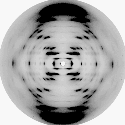 often included X-ray pictures that took
over 100 hours of exposure and in November of 1952
she obtained a pattern from the wet form... a stark
X-array of black stripes radiating from the center Franklin
presents the data at an in houses colloquium at King's
on the "X" pattern at a colloquium, which Watson
attended. Crick was keen on the "idea" that DNA was
helical. Watson
and Crick begin to build a model upon the "X" pattern.
Franklin was asked to review the model, which she
belittles and criticizes.The Director of
Cavendish Lab, Sir Lawrence Bragg, suggests Watson and
Crick do no further model building. The now famous photograph 51, [Anatomy of Photo 51] was
set aside and Franklin spends all her efforts on the dry
form pictures, that did not point as strongly toward a
helix. In fact Franklin
never formally published or reported on any of her X-ray
photos. Conditions at King's had gotten very unsociable.
In January of 1953 Franklin told Raymond Gosling to give
photo 51 to Maurice Wilkins. Wilkins was struck by the generous offer
of Franklin and could instantly see that the X-pattern
of photo 51 was demonstrative of a helix often included X-ray pictures that took
over 100 hours of exposure and in November of 1952
she obtained a pattern from the wet form... a stark
X-array of black stripes radiating from the center Franklin
presents the data at an in houses colloquium at King's
on the "X" pattern at a colloquium, which Watson
attended. Crick was keen on the "idea" that DNA was
helical. Watson
and Crick begin to build a model upon the "X" pattern.
Franklin was asked to review the model, which she
belittles and criticizes.The Director of
Cavendish Lab, Sir Lawrence Bragg, suggests Watson and
Crick do no further model building. The now famous photograph 51, [Anatomy of Photo 51] was
set aside and Franklin spends all her efforts on the dry
form pictures, that did not point as strongly toward a
helix. In fact Franklin
never formally published or reported on any of her X-ray
photos. Conditions at King's had gotten very unsociable.
In January of 1953 Franklin told Raymond Gosling to give
photo 51 to Maurice Wilkins. Wilkins was struck by the generous offer
of Franklin and could instantly see that the X-pattern
of photo 51 was demonstrative of a helix
Watson and Crick
pursued model building, using balls and sticks. Their
first model was a triple helix with the bases pointed outward. However, chemically it
wouldn't hold itself together, thus they knew it was
incorrect.
with the bases pointed outward. However, chemically it
wouldn't hold itself together, thus they knew it was
incorrect.
In May of 1952 Linus Pauling was to go the
Royal Society meetings in London, but he was denied a
passport by the U.S. State Department because of
McCarthyism suspicions for his anti-nuclear weapons
proclamations. It was suggested he might be a communist
sympathizer. A State Department telegram demanded that
Linus Pauling swear he was never a Communist Party
member. Peter Pauling,
Linus' son, did go to Cambridge and discussed his
father's January 28, 1953 published model of DNA, not
unlike the first Watson/Crick earlier incorrect version
that was criticized by Franklin. It proposed a 3
stranded helix with the bases on the outside.
Franklin
became fed up with the scientific atmosphere at King's
College and accepted a position at Brikbeck College,
London, with crystallographer J.D.
Bernal to work on the structure of viruses. In
her final seminar at King's College, she never showed photo 51. Watson
came to King's College to show Franklin
the Pauling model, but the
story goes that she confronted Watson, and so he
retreated and quickly walked out of her lab. Watson and Crick realized they had about a
2 month lead, before Pauling
realized that chemically his model wouldn't hold itself
together.
The key to Watson and
Crick's model building came from the MRC Report. J.T. Randall had
requested a report of the work in biophysics done by
several Medical Research Council's Biophysics Unit
funded projects, which included Franklin's work in
December of 1952. Max Perutz of the Cavendish Lab showed
the report to Crick in February of 1953. The MRC
Report included space groupings, which give geometric
depictions of atoms, immediately suggested to Crick that
the structure would be antiparallel and added momentum
to the view that the phosphates lie on the outside, not
inside. This was the breakthrough that Watson and Crick
needed. All that remained was fro Watson to get the
base-pairing right (A:T and G:C).
Together, Watson and
Crick, build a model of the structure of DNA as 2
helical chains, with antiparallel properties, and the
bases facing inward and paired to hold the molecule
together. Watson and Crick published their model. On
Saturday, February 28, 1953 it is reported that Crick came into the Eagle, a Cambridge
pub, and announced to everyone there that they had
"found the secret of life". Franklin,
in fact, came to Cambridge to see their model, and
readily accepts it. Save for an acknowledgement at the
end of their paper, Rosy Franklin is not recognized for
her contribution to the discovery of the structure of
DNA.
With the discovery of the structure of DNA solved, the
question of who gets the credit arises. The Director's
of the Cavendish and King's College labs approach Nature
and suggest that 3 papers be published in sequence: one
by Watson and Crick, one by Wilkins, Stokes &
Wilson, and a third by Franklin and Gosling. In April of
1953 the Watson and Crick paper appeared in the
journal Nature 171: 737-738
along with ones by Wilkins, Stokes, and Wilson Nature 171: 738-740
and by Franklin and Gosling Nature 171: 740-741
(April 25, 1953).
While Rosalind
Franklin's photo-51
was a pivotal moment in the discovery of the double
helix, it is the MRC report that provides the detailed
clue to the structure of DNA. At 38 (1958) Rosalind
Franklin died of ovarian cancer, probably due
to constant exposure to X-rays. In 1962 Francis
Crick, James Watson, and Maurice Wilkins
shared the Nobel Prize.
The discord
surrounding who deserved credit for each component of
the discovery of the structure of DNA is thought by some
to have slowed the progress of how DNA works for at
least a decade by limiting collaborations and the open
sharing of ideas.
end. |
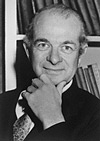


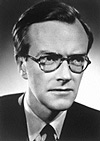
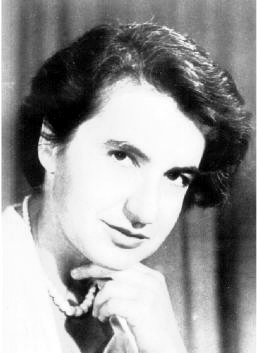
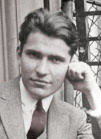
 often included X-ray pictures that took
over 100 hours of exposure and in November of 1952
she obtained a pattern from the wet form... a stark
X-array of black stripes radiating from the center
often included X-ray pictures that took
over 100 hours of exposure and in November of 1952
she obtained a pattern from the wet form... a stark
X-array of black stripes radiating from the center  with the bases pointed outward. However, chemically it
wouldn't hold itself together, thus they knew it was
incorrect.
with the bases pointed outward. However, chemically it
wouldn't hold itself together, thus they knew it was
incorrect.